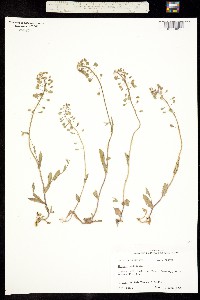Microthlaspi perfoliatum
|
|
|
|
Family: Brassicaceae
Perfoliate Pennycress, more...Clasp-Leaf Pennycress
[Noccaea perfoliata (L.) Al-Shehbaz, moreThlaspi perfoliatum L.] |
Stems unbranched or branched basally or distally, (0.3-)0.5-2.8(-4) dm. Basal leaves (not rosulate or loosely so); petiole 0.5-1.3 cm; blade ovate or broadly elliptic, 0.3-2(-2.7) cm × 2-10 mm, base cuneate or attenuate, margins entire or, rarely, obtusely and sparsely dentate, apex rounded. Cauline leaves: blade ovate-cordate or suboblong, (1-)2-4(-5.5) cm × (2-)5-15 (-20) mm, base cordate-amplexicaul, margins entire or repand, apex obtuse. Fruiting pedicels (2.5-)4-6 (-8) mm. Flowers: sepals (0.8-)1-1.5(-2) × 0.5-1 mm, (margins white); petals 1.5-3.5(-4.7) × 0.5-1.3 mm; filaments 1-1.5(-2) mm; anthers 0.1-0.2 mm. Fruits 3-6.5(-8) × (2.5-)3-6(-7) mm, base obtuse, apical notch 1-1.5 mm deep; wings 1-2 mm wide apically, much narrower basally; style obsolete or 0.1-0.3 mm. Seeds yellow-brown, 0.9-1.3(-1.5) × 0.7-1 (-1.2) mm. 2n = 14, 28, 42. Flowering Mar-May. Waste grounds, roadsides, fields, plains, thickets; 0-500 m; introduced; Ill., Ind., Kans., Ky., Md., Mo., N.J., N.Y., N.C., Ohio, Pa., Tenn., Va., Wash., W.Va.; Europe; Asia; n Africa. Annual herb with a long taproot 10 - 30 cm tall Stem: upright, branched above, with a waxy coating (glaucous). Flowers: in compact, branched clusters (racemes), which are borne terminally on the stems. Flower stalks to 4 mm long (longer in fruit). Sepals four, ascending, green with whitish margins, to 1.5 mm long, to 1 mm wide. Petals four, white, 2 - 3 mm long. Stamens six. Anthers yellow. Fruit: a pod (silicle), 4 - 7 mm long, egg-shaped with narrowed base and rounded tip, tips notched (wider than deep), winged. Fruit stalks horizontally spreading, to 6 mm long. Seeds two to four per chamber. Basal leaves: in a rosette, stalked, to 3 cm long, to 1.5 cm wide, egg-shaped or oblong or elliptic, coarsely toothed. Leaf stalks to 2 cm long. Stem leaves: alternate, stalkless, clasping, 1 - 3 cm long, progressively reduced, egg-shaped to oblong egg-shaped with rounded lobes at the base, sometimes coarsely toothed, with a waxy coating (glaucous). Similar species: No information at this time. Flowering: June to July Habitat and ecology: Introduced from Eurasia. An uncommon weed of roadsides, railroads, waste ground, fields, and disturbed areas. Occurence in the Chicago region: non-native Etymology: Thlaspi is the Greek word for cress. Perfoliatum means "with the leaf surrounding the stem." Author: The Morton Arboretum Annual 1-3 dm; cauline lvs sessile, ovate or ovate- oblong, 1-3 cm, entire or with a few teeth, the basal auricles blunt or rounded; pet 2-3 mm; mature pedicels horizontally spreading; frs obovate, 4-7 mm; convex below, the wing gradually widening to the summit, the wide open notch ca 0.5-1 mm deep and 1-2 mm wide; seeds smooth, 2-4 per locule; 2n=14, 28, 42, 70. Native of Eurasia, now found in fields, roadsides, and waste places here and there in our range. Apr., May. Gleason, Henry A. & Cronquist, Arthur J. 1991. Manual of vascular plants of northeastern United States and adjacent Canada. lxxv + 910 pp. ©The New York Botanical Garden. All rights reserved. Used by permission. From Flora of Indiana (1940) by Charles C. Deam This species was found in 1924 by Miss Edna Banta of Brooksburg, Jefferson County, who reports it to be a frequent to common weed between Brooksburg and Madison, a distance of 8 miles, and in other places in the county. Reported also as occurring on the campus of the University of Notre Dame, St. Joseph County. .…… Indiana Coefficient of Conservatism: C = null, non-native Wetland Indicator Status: N/A |




















































































